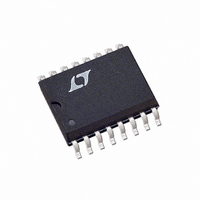LT1376CS Linear Technology, LT1376CS Datasheet - Page 22

LT1376CS
Manufacturer Part Number
LT1376CS
Description
IC SW REG 1.5A ADJ STP-DWN16SOIC
Manufacturer
Linear Technology
Type
Step-Down (Buck)r
Datasheet
1.LT1376CS8PBF.pdf
(28 pages)
Specifications of LT1376CS
Internal Switch(s)
Yes
Synchronous Rectifier
No
Number Of Outputs
1
Voltage - Output
2.42 ~ 21.5 V
Current - Output
1.5A
Frequency - Switching
500kHz
Voltage - Input
5 ~ 25 V
Operating Temperature
0°C ~ 125°C
Mounting Type
Surface Mount
Package / Case
16-SOIC (3.9mm Width)
Lead Free Status / RoHS Status
Contains lead / RoHS non-compliant
Power - Output
-
Available stocks
Company
Part Number
Manufacturer
Quantity
Price
Part Number:
LT1376CS
Manufacturer:
LINEAR/凌特
Quantity:
20 000
Company:
Part Number:
LT1376CS-5
Manufacturer:
AGERE
Quantity:
1 314
Part Number:
LT1376CS8
Manufacturer:
LINEAR/凌特
Quantity:
20 000
Part Number:
LT1376CS8#PBF
Manufacturer:
LINEAR/凌特
Quantity:
20 000
Company:
Part Number:
LT1376CS8#TR
Manufacturer:
LINEAR
Quantity:
7 388
Company:
Part Number:
LT1376CS8#TRPBF
Manufacturer:
LINEAR
Quantity:
10 119
Part Number:
LT1376CS8#TRPBF
Manufacturer:
LINEAR/凌特
Quantity:
20 000
Part Number:
LT1376CS8-5
Manufacturer:
LINEAR/凌特
Quantity:
20 000
Company:
Part Number:
LT1376CS8-5#TR
Manufacturer:
LT
Quantity:
41
LT1375/LT1376
APPLICATIONS
How Do I Test Loop Stability?
The “standard” compensation for LT1376 is a 3.3nF
capacitor for C
work for most applications, the “optimum” value for loop
compensation components depends, to various extent, on
parameters which are not well controlled. These include
inductor value (±30% due to production tolerance, load
current and ripple current variations), output capacitance
(±20% to ±50% due to production tolerance, tempera-
ture, aging and changes at the load), output capacitor ESR
(±200% due to production tolerance, temperature and
aging), and finally, DC input voltage and output load
current . This makes it important for the designer to check
out the final design to ensure that it is “robust” and tolerant
of all these variations.
I check switching regulator loop stability by pulse loading
the regulator output while observing transient response at
the output, using the circuit shown in Figure 16. The
regulator loop is “hit” with a small transient AC load
current at a relatively low frequency, 50Hz to 1kHz. This
causes the output to jump a few millivolts, then settle back
to the original value, as shown in Figure 17. A well behaved
loop will settle back cleanly, whereas a loop with poor
phase or gain margin will “ring” as it settles. The number
of rings indicates the degree of stability, and the frequency
of the ringing shows the approximate unity-gain fre-
quency of the loop. Amplitude of the signal is not particu-
larly important, as long as the amplitude is not so high that
the loop behaves nonlinearly.
The output of the regulator contains both the desired low
frequency transient information and a reasonable amount
22
C
, with R
INPUT SUPPLY
ADJUSTABLE
U
C
= 0. While this compensation will
INFORMATION
U
REGULATOR
SWITCHING
W
ADJUSTABLE
DC LOAD
Figure 16. Loop Stability Test Circuit
U
+
50Ω
100Hz TO 1kHz
100mV TO 1V
100µF TO
1000µF
TO
OSCILLOSCOPE
SYNC
of high frequency (500kHz) ripple. The ripple makes it
difficult to observe the small transient, so a two-pole,
100kHz filter has been added. This filter is not particularly
critical; even if it attenuated the transient signal slightly,
this wouldn’t matter because amplitude is not critical.
After verifying that the setup is working correctly, I start
varying load current and input voltage to see if I can find
any combination that makes the transient response look
suspiciously “ringy.” This procedure may lead to an ad-
justment for best loop stability or faster loop transient
response. Nearly always you will find that loop response
looks better if you add in several kΩ for R
if necessary, because as explained before, R
may require the addition of C
everything looks OK, I use a heat gun and cold spray on the
circuit (especially the output capacitor) to bring out any
temperature-dependent characteristics.
10mV/DIV
5A/DIV
P-P
3300pF
470Ω
Figure 17. Loop Stability Check
RIPPLE FILTER
4.7k
330pF
0.2ms/DIV
TO X1
OSCILLOSCOPE
PROBE
F
to control V
1375/76 F16
1375/76 F17
C
C
. Do this only
V
500mA
BEFORE FILTER
V
AFTER FILTER
LOAD PULSE
THROUGH 50Ω
f ≈ 780Hz
V
500mA
AFTER FILTER
OUT
OUT
OUT
pin ripple. If
C
AT I
AT I
AT I
above 1k
OUT
OUT
OUT
=
= 50mA
=
13756fd












